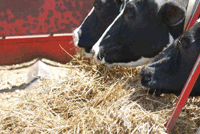Put a plan of action in place to make the most of this year's forages.
With extreme drought conditions affecting more than half of the U.S., and in excess of 30 percent of the corn crop rated at poor or very poor conditions this year's forages are likely to present some challenges.
"Unfortunately you can't control the plant that's presented for harvest," says Martha Baker, dairy nutrition specialist with Purina Animal Nutrition LLC. "But you can control what you do with it."
The upside to dealing with drought-stressed forages is that total plant digestibility tends to go up and they tend to be good quality feeds, because of higher stem to leaf ratios. "Improved digestibility offers some advantages and is something dairy producers and nutritionists need to keep in mind when formulating rations with this year's crop," she says.

To handle and feed drought-stressed forages, Baker offers the following advice:
Decide when to harvest. Knowing when to harvest corn silage may be a challenge this year as some of the corn crop likely did not develop ears because it didn't pollinate. To ease the decision on when to harvest, Baker advises to keep an eye on total plant dry matter; aiming for a total plant dry matter of 30 to 38 percent. "Remember the forages will dry quicker, so be sure to watch the rate at which the plant is maturing and drying," she adds.
Keep an eye on nitrate levels in the corn crop. Baker explains that nitrate levels can be problematic in drought-stressed corn; nitrates start to accumulate in the plant when it stops converting them into plant protein. The bottom 6 to 8 inches of the plant has the highest nitrate levels.
"If you're not dealing with green chop, nitrates shouldn't be an issue because ensiling reduces nitrates by 40 percent," she says. "But if you do feed green chop, consider raising the corn head during harvest, as the herd could experience major toxicity issues if the plant is fed."
To evaluate nitrate levels in the crop prior to harvest, submit a sample to a laboratory for evaluation. Samples should be taken at the height that the plant will be chopped.
Use inoculants. "If you don't normally use inoculants, this year they should certainly be considered," says Baker, not only are the natural bacteria levels lower, the sugars and carbohydrates needed for efficient fermentation will be lower. With forages in such short supply any step that can be taken to reduce dry matter losses should be taken.
Watch for prussic acid poisoning. If you are working with grass hay or haylage, Baker advises to keep an eye out for prussic acid poisoning. "The bottom portion of the stem poses the most danger."
Get a handle on what the forage inventory looks like for your operation. Talk with your nutritionist today to put a plan in place to help control feed cost through 2013 and still allow for high production and a healthy rumen, says Baker, noting that producers may need to look to forage and fiber extenders to fill a void in inventory.
"Regardless of the forages you are presented with, it should always be top of mind to feed every cow, exactly what she needs, where she needs it, when she needs it nothing more and nothing less," says Baker. This approach will aid dairy farmers in capturing opportunities for improved efficiency.
For more information on feeding drought-stressed forages, contact your local Purina Animal Nutrition representative or go to: www.lolfeed.com.
Purina Animal Nutrition LLC, in connection with its wholly owned subsidiary Purina Mills LLC, is North America's leading feed company serving producers nationwide through local cooperatives and independent dealerships by providing an extensive line of animal nutrition, ingredients and expertise.
07.27.2012